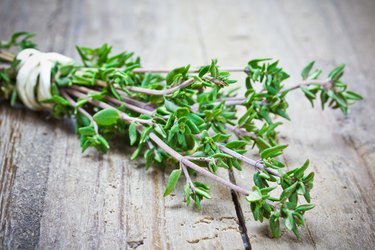
Can you eat thyme stems? Technically, maybe – but that's not the part of the plant that a recipe refers to when it calls for fresh garden thyme (Thymus vulgaris). If you're unfamiliar with the thyme plant, it's a pretty simple one to cook with. The leaves of this perennial evergreen are highly aromatic and have a woodsy flavor that pairs well with meat, fish and many other common herbs. Those leaves are the part of the plant you want to eat, though the stems have some culinary value too.
About the Thyme Plant
Video of the Day
There are actually many varieties of culinary thyme plants, each with its own unique flavor profile. Some varieties are especially well suited for certain uses. Lemon thyme (T. x citriodorus) is a perfect complement for delicate fish dishes, for example. Caraway thyme (T. x herba-barona) mimics the flavor of caraway seeds and can be added to roasts and other beef dishes. But what we think of as "regular" thyme (garden thyme) can be used in any recipe that calls for this herb.
Video of the Day
Thyme plants flourish in full sunlight and typically need minimal watering. Common thyme may be grown outdoors in USDA plant hardiness zones 5 through 9 or in an indoor container garden. A garden thyme bush will typically grow to be up to 2 feet high and 2 feet wide. The small green leaves appear to be diamond-shaped or oval-shaped.
When you need thyme for cooking, cut off sprigs with garden shears. Leave at least 5 inches of growth on any stem you cut from the thyme bush. Thyme can be harvested at any time of year if you have a plant that's flourishing. However, the herb is considered to be at peak flavor in early to midsummer before thyme starts flowering.
Can You Eat Thyme Stems?
Can you eat thyme stems? This is probably what confuses novice chefs the most about cooking with the herb. After all, recipes sometimes call for a "sprig of thyme," which suggests the entire plant is edible.
In fact, thyme stems are too woody to be chewable or appetizing, but they can be used to infuse foods with deep thyme flavor. A soup or stew recipe might call for whole sprigs of thyme to be added to the pot early in the cooking process and fished out before the food is served.
You can make herbs sachets (also called bouquets garni) using sprigs of thyme plus other herbs wrapped in cheesecloth and tied with food-safe twine. Submerge these little bundles into soups, stocks, rice and other dishes while they cook. Tailor the herbs in your bouquet garni to the dish you're making. For a rich beef stew, you might pair bay leaves, peppercorns and fresh oregano with thyme sprigs. For a chicken stock, you might pair thyme with parsley, rosemary and bay leaves.
Preparing Fresh Thyme for Cooking
If you've cut a few sprigs straight from your thyme bush and your recipe calls for chopped thyme, first wash the springs under running water. Next, pluck the leaves from the stems with your fingers and chop them on a cutting board with a chef's knife. This shouldn't take more than a few minutes if you only need a few teaspoons of chopped thyme.
A mesh strainer will speed up the job, which is useful if you need a larger quantity of thyme. Run each spring of thyme through one of the strainer's holes. All the leaves should be stripped off and contained within the strainer.
If you have freshly cut thyme sprigs but you don't need them yet, loosely wrap them in damp paper towels and put them in plastic bags. Refrigerate thyme for up to 10 days but use it earlier if possible for maximum flavor.